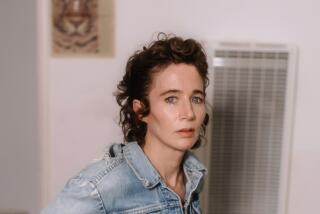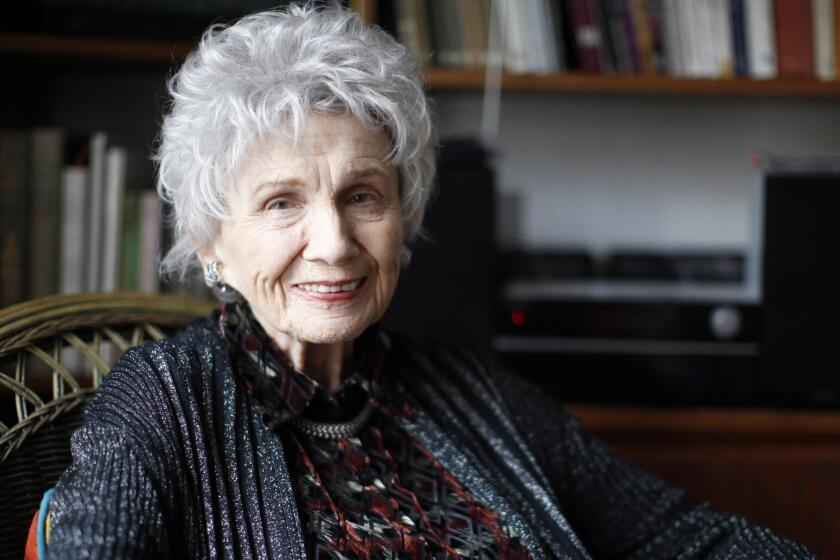Bird on the street
An 8-foot-tall, lemon-yellow bird with orange feet is pretty hard to miss, and yet this enduring symbol of “Sesame Street” and one of the world’s most recognizable public figures often travels incognito. At least that’s what happens when Big Bird is out and about in the persona of the considerably less recognizable Caroll Spinney.
He’s the Muppeteer who has portrayed Big Bird and Oscar the Grouch since Children’s Television Workshop’s landmark “Sesame Street” revolutionized children’s television 34 years ago.
Spinney is trying to make his own face -- genial, rosy-cheeked, framed by soft, snowy white hair, neatly trimmed goatee and mustache -- more familiar at the moment. Named one of the nation’s Living Legends by the Library of Congress in 2000, he has been making an exhaustive round of TV, radio and print media outlets recently to publicize his new book, “The Wisdom of Big Bird (and the Dark Genius of Oscar the Grouch).”
Published by Villard, the book, despite its title, is more behind-the-scenes biography than inspirational tome -- although, as Spinney told KPCC’s Larry Mantle last week, he found it shelved in the religion section in one bookstore. Amazon.com has been offering it as a combo deal with Paul Berman’s “Terror and Liberalism.” Go figure.
Spinney frequently transported his visitor during a recent interview to an alternate reality, by channeling Big Bird’s sweet, comic tenor and Oscar’s raspy growl. He was clearly eager, however, for his own voice to be heard, alternating between pride and self-deprecation as he spoke volubly of his life as one of Muppet creator Jim Henson’s “Sesame Street” originals.
“Of course, now I’m getting recognized because of plugging the book,” he said. And the reward “is that I’ve talked to dozens of people on this tour who say, ‘You have no idea how important you were to our family.’ I don’t know how I could have been so fortunate.”
There are at least three reasons.
No. 1: Spinney’s passion for puppets. He began performing when he was 8 and did shows throughout junior high, high school, college and during a stint in the Air Force, before becoming a puppeteer for 10 years on TV’s “Bozo’s Big Top.”
No. 2: Serendipity. Jim Henson saw Spinney perform at a puppet festival in April 1969. That same day, Henson invited Spinney to work for him on an “experimental” children’s program called “Sesame Street.” (“He was so gentle,” Spinney said of Henson, one of his all-time heroes, who died in 1990. “He was just such a good fellow. It was devastating to lose him.”)
No. 3: Spinney’s “inner child” became his “inner bird.” The result was that a goofy-looking, tattery country yokel originally meant to provide comic relief became a compassionate, gentle, somewhat insecure 4 1/2-year-old (in later years, a more mature 6-year-old) with whom the young viewers could identify.
The catalyst for that transformation, Spinney said, was a second-season script that had Big Bird visiting a day-care center. “I thought, if this guy wants to be with kids, maybe I should play him like he was a kid.” From then on, Big Bird, with smooth new feathers and a shapelier head, became the resident Muppet kid on the block, considerably shaped by Spinney’s own life.
“In a way, it’s been like replaying my childhood,” said Spinney, who grew up in Boston, “but a little more the way I’d like it to have worked out. Big Bird gets frustrated and a little insecure, because I certainly was. I was the small kid in the neighborhood and I was pushed around a lot. I always wanted people to like me, because I wasn’t cool,” he said.
Big Bird was a physical as well as a creative challenge, however. Spinney spent the first season barely able to see through the bulky costume. In the second season, he was given an “electronic bra” to wear that featured a tiny TV monitor. He could then see what viewers were seeing, and deftly adjust his movements accordingly.
At 69, lanky Spinney, father of three, grandfather of three -- he met his wife, a researcher, on the show -- still seems amply up to coping with the tricky costume-puppet that requires him to extend his right arm straight up over his head for long periods to manipulate the character’s head and eyes.
“I’m really good at painting ceilings, ‘cause the muscles have built up pretty strong,” he joked.
Oscar the Grouch, an easier proposition, hasn’t changed much over time, except that he was made from a green bath mat, rather than an orange one, after the first season. His personality was inspired by a grumpy Bronx cabdriver who, after asking “Where to, mac?,” treated Spinney to 20 minutes of expletives aimed at then-Mayor John Lindsey.
“As he went on and on, I said, ‘That’s the voice.’ ”
“Sesame Street’s” first target audience, older preschoolers and above, has skewed younger over the years as more viewers not yet out of diapers tune in. That, and the advent of an adorable scene-stealer named Elmo, has meant that Big Bird is more big brother than the little kid on the block.
Spinney readily admits that losing the lion’s share of attention was an adjustment -- Elmo does more “Hollywood Squares” appearances than Big Bird now, he said with more than a hint of regret -- but he sings the praises of Elmo’s talented operator, Kevin Clash.
“Elmo’s the cutest little thing and Kevin, he’s so clever, I call him the complete puppeteer. Big Bird still has his place, even if he’s not as prominent as he was, and that’s OK with me. We have so many babies watching now and Elmo and Zoe are just right for that age.”
Spinney doesn’t hesitate when asked what he considers Big Bird’s best work during the past 34 years -- years that include numerous guest spots on TV shows, traveling to China to help create the Chinese version of “Sesame Street” and conducting symphony orchestras across the country and abroad.
“The finest thing was the Will Lee episode,” he said.
Will Lee, one of the original human actors on the show, played Mr. Hooper, with whom Big Bird had a special relationship, even though, in a running gag, he could never get Mr. Hooper’s name right. In the 12th season, when Lee died of prostate cancer, his character’s death was dealt with in “the most beautiful, sensitive script” by then-head writer Norman Stiles, in which Big Bird, with the help of the grown-ups on the show, tearfully begins to understand that Mr. Hooper won’t be back.
“All of our emotions were real,” Spinney said. “We were saying ‘Mr. Hooper,’ but we were saying goodbye to Will.”
Being an unrecognizable celebrity may elicit mixed emotions, but when it comes to children, Spinney would rather maintain his anonymity.
“I’ll have people meet me on the street with their 3-year-old and they’ll say, ‘Do you know who this is? There’s a man inside Big Bird, and this is the man.’
“This is bad news to a child,” he said, shaking his head. “I think of my little nephew. He says, ‘I know you’re a puppeteer and I know you do Oscar and he’s not real, but I know Big Bird is real.’ ”
Spinney isn’t prone to merging, “Twilight Zone”-style, with his feathery puppet persona, but keeping it “real” is more than a job.
“So much of myself,” he said simply, “of who I am, of my soul, is in the Bird.”
More to Read
Sign up for our Book Club newsletter
Get the latest news, events and more from the Los Angeles Times Book Club, and help us get L.A. reading and talking.
You may occasionally receive promotional content from the Los Angeles Times.






